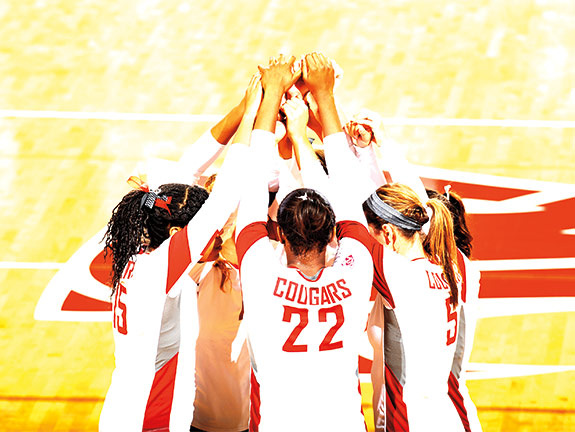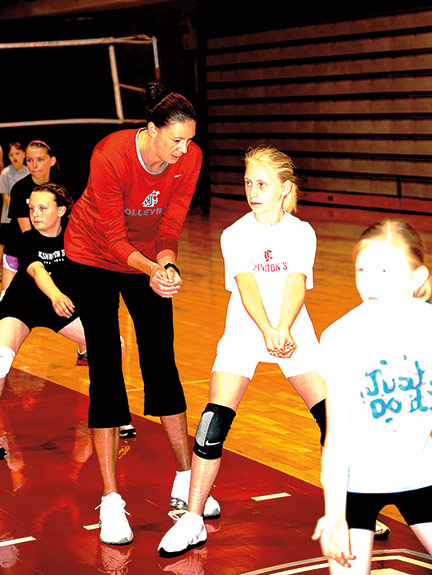The Washington State University volleyball offices just off Bohler Gym are a lively place, even on an off-season Tuesday in mid-winter. The far office is buzzing with the voices of coaches planning the afternoon practice, the phone rings and rings again, and an athlete studying on a couch greets another sweeping through between classes and the weight room.
The team’s last public game was in November, but recruitment is in full swing, there is some light training, and coaches and staff are planning for a series of summer camps for nearly 300 grade school, middle school, and high school girls. Several other WSU sports programs, including tennis, football, and track and field, offer summer camps, drawing thousands of kids to Pullman for a chance to play in the Division I venues like Martin Stadium and Mooberry Track. But Coach Jen Stinson Greeny ’99 and her staff have a particularly deep connection: They were all WSU volleyball campers themselves. Greeny first experienced the camp as a high schooler wanting to build her volleyball skills for her Davenport High team. “Basketball was my sport,” says Greeny. It had to be. Her dad was the coach. “But the camp was my first real introduction to Pac-10 college volleyball.”
Stephanie Logan, a 6’2″ right-side hitter for the Cougs, got her first taste of volleyball at WSU as a “little spiker,” an elementary school student who learns the ABC’s of the sport directly from the athletes. She watched the players deftly jump and sail across the court. “They were the coolest people in the whole world,” she says. “I idolized them so much.”
At 14 she got to play in a tournament in Bohler Gym. “I thought that was the coolest thing in the whole world,” she says. “I never realized I would be back here as a Coug.” She cemented her love of volleyball, though, through the summer camps. “For the younger kids it’s about making it fun,” says Logan, who now coaches at the camps. Games and encouragement ease the girls into learning the rules. “It’s fun to watch them start to get it,” she says. For the older girls already hooked on the sport, it’s about honing their skills. “It’s even more fun to watch as things start to click with them,” she says. “The ones who were here last year remember what we taught them and are so excited to show how they’ve improved.”
WSU hosts three major volleyball camps in June and July. The first brings in girls from first to sixth grade and introduces them to the basics of volleyball before starting them in team play. “If it’s their first time ever, they look at us and they’re like—we have no idea what you’re talking about,” says Katie Hinrichs, director of operations for the volleyball program as well as camp coordinator and former camper. “The student athletes break it down for them. It’s really fun to watch, and really good for the student athletes as well.”
The second camp is an overnight experience for middle and high school students. They live in the dorms, eat at the cafeterias, and over three days have 27 hours of instruction in morning, afternoon, and evening sessions. They also attend “chalk talks” where the coaches explain the recruiting process and offer some basic ideas about nutrition, strength, and conditioning. They may not all be destined for Pac-12 play, but there are schools for everyone, says Hinrichs. “We tell them out to reach out to different schools.”
The camps focus on basic ideas of hydration and a healthy lifestyle, including getting plenty of fruits, vegetables, and protein, says Hinrichs. “We touch on sleep, too. We let them know that it’s a huge indicator of how you’re going to perform, not the next day, but the day after.” The campers are also taught drills they can do “in their garage, in the park, or with a friend” to prepare themselves for their school tryouts.
The summer camps culminate with a final camp for team training and tournaments. Players from specific high schools come together to work on not only their individual abilities to spike, set, block, tip, dig, and serve, but to build their teamwork. Nearly 200 students from Pullman, Moscow, Montana, and the west side of Washington pour into Pullman for the team sessions. “It’s to gain experience before the start of their high school season,” says Hinrichs. “We give them tools they can take home and use as high school athletes.”
For Greeny, the excitement of being a high schooler around the college players was unbeatable. “It was just such a fun experience to watch them demonstrate the skills and have them coach us,” she says. That first year, she landed on the top team, coached by assistant coach Mashallah Farokhmanesh. He urged her to consider pursuing volleyball in college and even talked with her dad about it. “That was my first time imagining that volleyball would even be an option,” says Greeny. She was highly recruited in both volleyball and basketball. “But I had played basketball a really long time and volleyball was sort of new to me. It was an exciting sport and I enjoyed the coaches,” she says. So her first college decision was volleyball, and her second was to come play it at WSU. “I got four years with the volleyball team,” she says. Then, smiling slyly, she says, “I worked in a little basketball, too.”
Once in college, her camp days were far from over. Coach Cindy Fredrick worked her players into the summer camps, pushing them to figure out how to teach the sport to others. “It was my first experience coaching,” says Greeny. “I liked it.” So much so that it became a career.
Now as head coach of the WSU volleyball program, Greeny not only leads and oversees the camps, she uses them to prepare her own players. “We want our student athletes to be role models in the community,” she says. “We love when our players are coaching because they have to look at the game from a different point of view.” They mature as players, and they become more aware of the world outside themselves, she says.
She also gets to coach the coaches, who come along with the teams. “It gives them a great time to pick our brains,” says Greeny. “They come in saying they think they could be better, but they don’t know how.”
Finally, the high school campers can get a taste of both life on a college campus and life as a student athlete and Greeny and her coaches get to work first-hand with students they may eventually be recruiting. A few campers come back year after year, and eventually graduate into a place on a college team. “Even though most of them will not be college athletes, we want to offer them an advantage,” says Greeny. “We want to remind them that they can always be learning something.”


